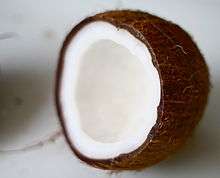Nata de coco
|
Nata de coco are the translucent cubes in this fruit salad. | |
| Type | Confectionery or dessert |
|---|---|
| Place of origin | Philippines |
| Main ingredients | Coconut water |
Nata de coco (also marketed as "coconut gel") is a chewy, translucent, jelly-like food produced by the fermentation of coconut water,[1] which gels through the production of microbial cellulose by Acetobacter xylinum. Originating in the Philippines, nata de coco is most commonly sweetened as a candy or dessert, and can accompany a variety of foods, including pickles, drinks, ice cream, puddings, and fruit cocktails.[2]
Etymology
Nata de coco was first created in 1973 in the Philippines by attempting to preserve coconut water as a jelly-like substance. Its name comes from the Spanish, and means "cream of coconut" or "coconut milk-skin".[3] In the 20th century, the demand for coconuts increased. Products from coconuts became a major export product of the Philippines, including nata de coco.
Nutrition
Nata de Coco is mainly made from coconut water, so it has a modest nutritional profile. One cup of Nata de Coco (118 grams) contains 109 calories, 1 gram of protein and 7 grams of carbohydrates. It is often characterized as healthful since it contains dietary fiber to aid digestion while carrying fewer calories compared to other desserts, gram for gram.
Production
Commercially made nata de coco is made by small farms in Thailand, Malaysia, the Philippines, especially in Laguna and Quezon,[4] and Indonesia, especially in the Special Region of Yogyakarta, and in Thailand, it is commonly sold in jars.
The primarily coconut water dessert is produced through the following steps:
- Extraction of the coconut water,
- Fermentation of the coconut water with bacterial cultures,
- Separation and cutting of the produced fat of the nata de coco,
- Cleaning and washing off the acetic acid,
- Cutting and packaging
Dessert
Nata de coco can be consumed on its own, but it can be used as an ingredient as well for fruit salads, coconut cakes, ice creams, soft drinks, bubble tea, and yoghurts.
References
- ↑ Sanchez, P.C. (2008). Philippine Fermented Foods: Principles and Technology. University of the Philippines Press. p. 378. ISBN 978-971-542-554-4.
- ↑ Sharangi, Amit Baran; Datta, Suchand (2015). Value Addition of Horticultural Crops: Recent Trends and Future Directions. Springer. p. 151. ISBN 9788132222620. Retrieved 21 April 2017.
- ↑ Tietze, Harald; Echano, Arthur (2006). Coconut: Rediscovered as Medicinal Food. Harald Tietze Publishing P/. p. 37. ISBN 9781876173579. Retrieved 21 April 2017.
- ↑ Grimwood, Brian E.; Ashman, F. (1975). Coconut Palm Products: Their Processing in Developing Countries. Food & Agriculture Org. p. 164. ISBN 9789251008539. Retrieved 21 April 2017.
